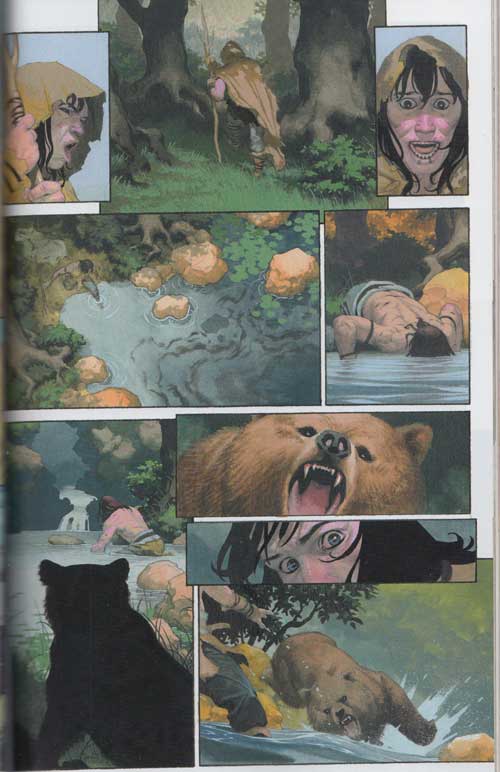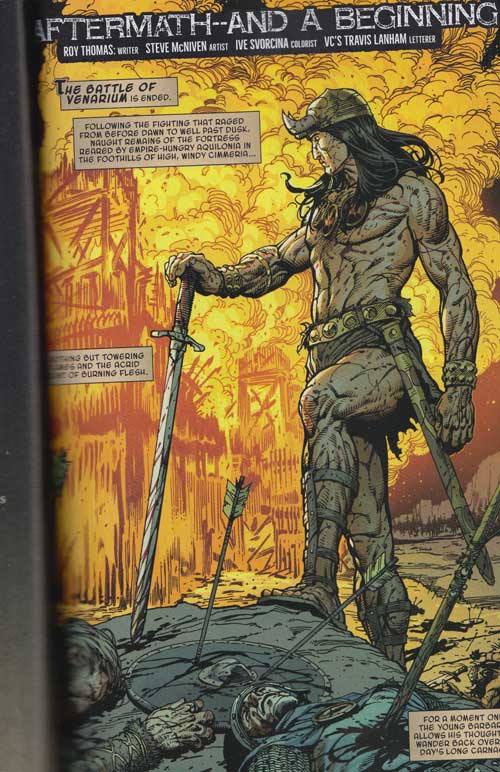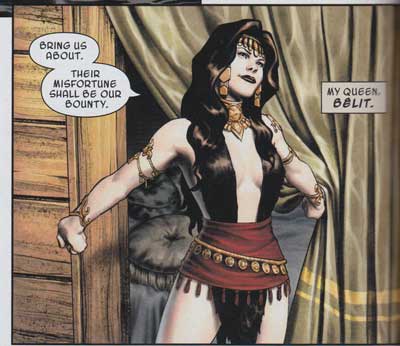Conan the barbarian : Exodus and other tales.This thin TPB includes stories from
Conan the barbarian: Exodus #1, Savage Sword of Conan vol. 2 # 12, and
King-Size Conan #1. The latter was an anniversary issue celebrating 50 years of Conan in comic-book form, which doubtless explains why this book evokes several eras of the Cimmerian's career… but not in the traditional sense, with Conan as young thief, mercenary, pirate and king; rather, it seems to cover different eras of Conan as a published character.
In a sense it presents the Cimmerian as a legendary character, since a legend has no definitive version. We already have the
Weird Tales Conan; the deCamp and Carter pastiche Conan; the Roy Thomas Conan; the mid-80s Marvel Conan; the Kurt Busiek/Tim Truman Dark Horse Conan; the Brian Wood emo Conan; the Schwarzenegger Conan; even the animated cartoon, TV series or Jason Momoa Conan, although I’m not aware that those versions ever influenced the comics. But you get the idea: Conan is now a protean property.
As such, is this book a tribute to the way Conan’s creator wrote his stories, as if they were told by an old adventurer around the campfire (with the expected exaggerations and flights of fancy)? Is it rather an example of how most Conan comics really don’t give a hoot about giving the character one coherent story and are just happy with presenting the adventures of a wizard-killing strong guy in a loincloth? Let the reader decide. Most readers will just be happy to read a good yarn anyway.
But this is my review, and I'm a hard to please Conan fan, so...
Assuming that this book is grounded in the Marvel version (if only because of the company’s name on the cover), then it opens with an error. The first sentence goes “After fifteen winters, Conan the barbarian headed south from his native Cimmeria, fighting to survive in the ancient time known as the Hyborian age”.
In a
What if..? story, maybe. But not in Robert Howard’s stories nor in the Marvel comics; nor, in fact, in the Dark Horse ones (because Kurt Busiek actually
did care about Howard’s works). Conan left Cimmeria and went
north, not south. And before I’m accused of being a curmudgeon who is triggered by continuity mistakes that only nerds care about (which I admittedly am, when it comes to Conan), let me point out that
in this very issue we see another story about Conan leaving Cimmeria… and this time going
north, because that particular tale is written by Roy Thomas, another person who, like Busiek, cares about the source material. But anyway.
Chapter one : The first chapter is a beautifully-illustrated piece of work by Esad Ribic. Since Ribic provided many covers for the new, revamped Marvel Conan titles, it could be seen as representing that new era in Cimmerian adventures.

It’s an almost silent story, as the only bits of dialog here and there are written in runes (Conan not understanding what is said, any more than the reader does). It really looks good, with lovely colours and great-looking wildlife.
Young Conan travels snow-encrusted Cimmeria and meets wolves, cougars and bears while traveling south. He eventually happens upon a still-smoking battlefield and appropriates a horse and helmet (although it was stated waaaaaay back that Conan was very unfamiliar with horses before reaching Corinthia; in fact, in the first volume, he never rode his own horse until
Conan the barbarian #8). Captured by castle-dwelling southerners, Conan is stringed up between two poles and roughed up by a bearded dude, and left to rot overnight. The lad throws a mean look at the bearded fellow who goes back to sleep in his castle. The next morning, the man's servants discover him dead in his bed, a bloody whole in his belly; Conan has escaped and gotten even.
The plot is really just an excuse to show Ribic fantastic artistic chops, and as such it does the job.
Chapter two :Another one representing the new Marvel Conan. Written by Patch Zircher, drawn by Edgar Delgado.
The art is all right, the story pretty standard. Conan (who talks about himself in the third person a lot) saves a little girl from people who are apparently cultists, and who say the little girl is evil. Were this the first time we’ve seen this plot it might have an unexpected twist, but come on… From the moment we learn about the cultists, we know they’re probably right and that the kid probably
is evil.
Conan makes a reference to the Serpent Men as if they were habitual enemies of his, which they never used to. Oh, well. After 50 years, what’s a little retcon now and then? I just don't like the general "superheroisation" of Conan, with him supposed to have recurring foes (the serpent men!) or an arch-nemesis who pops up regularly (Thoth-Amon). Both were encountered fairly late in Conan's life, and their encounters were few and far between. And they hardly knew about his existence until near the end.
Chapter three : Script by Roy Thomas, art by Steve McNiven, who seems to go for a Rafael Kayanan-inspired-by-Barry Smith look. (I quite like the look).

Naturally, this one pays homage to the early days of the Conan comic, and it is a bridge between
Conan the Adventurer #1 and
Conan the barbarian #1. It’s also in this chapter that Conan leaves the site of Venarium, crosses Cimmeria (due north!) and gets to Aesgaard, just in time for CtB#1. Nothing much more than that happens! (I liked how McNiven incorporated a prop from CtB#1: a type of odd-shaped sword that Barry Smith immediately abandoned in favour of more realistic-looking weapons).
It’s Roy Thomas, so I’m happy… but it’s really light. Still, even a few pages are worth two thumbs up if they get their continuity right!
Chapter four : Script by Kurt Busiek, art by Pete Wood.
Here we pay homage to Dark Horse’s Conan, and I *loved* Busiek’s, Truman’s and van Lente’s work on the character for that company. I fact, it’s more than a homage: this
is Dark Horse’s Conan, as events mentioned in the story refer to Dark Horse’s chronology rather than Marvel’s (placing "The God in the Bowl" before "The Tower of the Elephant"). Conan is wearing his old yak-horn helmet (a Marvel feature) but the rest of the story’s elements are from Busiek’s run at Dark Horse.
Even better : it harkens back to my favourite scene in that run, that in which Conan listens to philosophers discuss esoteric things!
Chapter five : script by Chris Claremont, art by Roberto de la Torre, who does a pretty good John Buscema impression. It reads like a homage to the ‘1980s Savage Sword of Conan.

“Claremont?” I thought with apprehension… I still remembered SSoC #74, which was a smorgasbord of superb Claremontisms that were the best at what they did, body and soul, and the result wasn’t very nice. But hey, let’s cut the man some slack and see what this is about.
It begins with Conan working as a mercenary for King Yezdigerd of Turan, so we’re not in the old Marvel continuity. Maybe we’re in the new one that Jason Aaron crafted for the relaunched series. Anyway. Conan fights a woman warrior from some rebel tribe and naturally she is one of the best on the battlefield. Conan kills her (even if she was possibly better than he is, according to the all-knowing caption writer), and then he encounters the woman’s daughter, another warrior who snarls and swears she’ll kill him even if the arrow protruding from her back suggests she isn’t long for this world. Conan easily disarms her and has a frank and respectful chat, two equal warriors talking to each other, and as she dies he says they’ll meet again and he’ll be ready for her if she wants to kill him then.
It’s actually the most touching story in the whole book. Much better than SSoC #74! Kudos to Chris.
Chapter six : story and art by Kevin Eastman, and not corresponding to any previous publishing era! Perhaps it’s a sign of things to come?
Eastman’s art has a strong undergroung feel to it, and I love it! We’ve rarely (or never) seen this kind or art in a Conan story.

The tale is pretty run-of-the-mill, just like the above one about the demon girl. Conan escapes from a band of brigands and is rescued by a village of kindly people who are clearly wearing red shirts. After recuperating from his ordeal he leaves them, comes back with an offering of venison, and finding them all slaughtered by the brigands goes to avenge them. Which he does.
It’s the one truly new thing in this book, honestly.
Chapter seven : story by Steven S. Knight, art by Jesus Saiz, and an apparent homage to the emo Conan that got me to drop Brian Wood’s version. It is set in the same time period, with Conan among the Black Corsairs.
Bêlit is depicted as a mix between the Buscema and Cloonan versions, which is a nice touch; I really liked both, for different reasons. Conan is also a mix between the Buscema and Cloonan versions, wearing both a fur loincloth and pants.

Is this set in the Dark Horse continuity? I would say yes, as Marvel’s Conan never sighed like a lovesick puppy as he does here; furthermore, M’Gora is called
N’Gora here, as in Howard’s original story
The Queen of the Black Coast and as in the Dark Horse comic, but not as in Marvel’s earlier Conan books.
The crew of the
Tigress encounters a gigantic and scary-looking ship; men, animals and fell creatures seem to have been bonded to its hull. In the hold, the pirates discover much loot, as well as a creature made of wood (he’s actually part of the ship, or is the ship itself). The critter speaks in riddles (“I am the always… I am the forever…”) and apparently he has been waiting for Conan a very long time. Why? So Conan could kill it… which takes nothing more than setting him on fire, something that’s easy as pie as the creature is rather flammable. In gratitude, the easily-satisfied monster gives Conan a vision that we are not privy to, but that we understand reveals how Bêlit will die, a little while later.
Boy, I disliked that one. The Conan I know would *never* simply accept the dictates of fate and indulge in lovestruck and melancholy soliloquies instead of saying "Bêlit, we're never going near the Zarkheba river because you'd die there". Heck, the Conan I know would NEVER share his thoughts, period, either in thought bubbles or in captions. Powerful magical creatures used to have some sort of purpose in stories; what they are, why they are there, why they can't bloody set
themselves of fire if they so desperately want to die? They didn't just show up in fantastic ships full of tantalizing mysteries and then just go "please kill me, take the gold and go". But this one does. It's rather disappointing!
Overall mark for the book : something like a B minus.